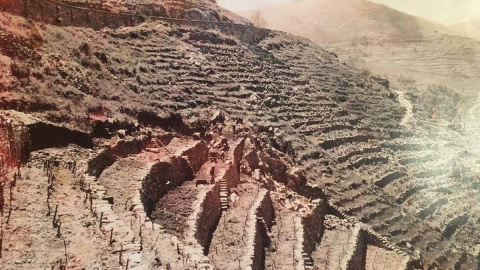
17.2. Viña Cortezada
Here we are looking out over the vineyard of Cortezada, which is one of Ribeira Sacra’s most iconic wineries, now owned by the Adega Algueira winery in Sober. It took 28 years to construct the 4 hectares of stone structures and terraces at this property, where the gradients along the slopes are as high as 50-60º.
THE TERRACES
The work required to convert slopes like these into cultivated land was hard, difficult work, which typically required years of dedication. The process would begin by clearing the land surface, then excavating a space along the lower edge of each planned terrace, which was done partly to dig up stones that could be used to build the terrace walls. Once those walls had been built, a layer of smaller stones was filled in behind them, then a mixture of earth and gravel. A final layer was afterwards added with fertile topsoil for planting, brought in from the slopes higher above. Finally, the grapevines were planted along the downslope edge of the terrace, with the workers having access to them from the upslope side.
Building terrace walls like these was an ideal way to grow grapes. The absence of mortar between the stones helped improve drainage to prevent excessive water in the soil during heavy rainfall. The stones also act as a natural source of warmth, as they collect heat from the sun during the day and radiate it back out at night, which helps maintain a stable soil temperature.
RUTH MATILDA ANDERSON
Ruth Matilda Anderson was an American photographer who travelled throughout Galicia between 1924 and 1926. During her travels she took more than 5,000 photographs for the Hispanic Society of America, documenting the landscapes, customs, and work practices she saw in the region.
She visited the A Cortezada vineyard in 1925, when construction was just being completed, and she captured a group portrait of 14 men from the work crew there.
 Directions
Directions 